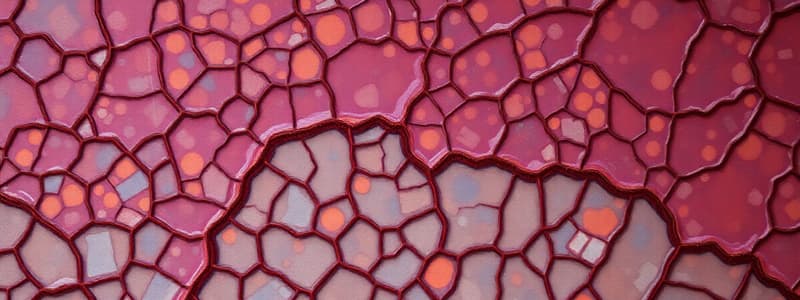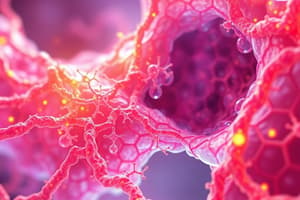Podcast
Questions and Answers
What process describes the conversion of glucose into energy in cells?
What process describes the conversion of glucose into energy in cells?
- Fermentation
- Cellular Respiration (correct)
- Photosynthesis
- Glycolysis
Which organelle is primarily responsible for ATP production?
Which organelle is primarily responsible for ATP production?
- Golgi Apparatus
- Nucleus
- Mitochondrion (correct)
- Endoplasmic Reticulum
Which of the following best describes the role of enzymes in biochemical reactions?
Which of the following best describes the role of enzymes in biochemical reactions?
- They are consumed in reactions
- They act as catalysts (correct)
- They provide energy to reactions
- They increase the activation energy
In which phase of the cell cycle does DNA replication occur?
In which phase of the cell cycle does DNA replication occur?
What is the main purpose of the ribosomes in a cell?
What is the main purpose of the ribosomes in a cell?
Flashcards
String
String
A sequence of characters, used to represent text or other data.
Variable
Variable
A variable that can hold different values over time, allowing for dynamic data.
Program
Program
A set of instructions that a computer can follow to complete a task.
Database
Database
Signup and view all the flashcards
Compilation
Compilation
Signup and view all the flashcards
Study Notes
Connective Tissue
- Connective tissue provides a structural framework and support for the body, connecting tissues and cells.
- Interstitial fluid within connective tissue provides metabolic support to cells, acting as a medium for nutrient and waste transport.
- The extracellular matrix (ECM) is the major constituent of connective tissue, comprised of protein fibers (e.g., collagen, elastic) and ground substance.
- Ground substance is a complex of proteoglycans, glycosaminoglycans, and multi-adhesive glycoproteins, enabling nutrient and waste exchange.
- The diverse types of connective tissue reflect various cellular, fiber, and ground substance compositions, exhibiting remarkable structural, functional, and pathologic diversity.
- Connective tissue originates from embryonic mesenchyme, a tissue derived from the mesoderm.
- Mesenchyme comprises a population of undifferentiated cells, rich in hyaluronan and with minimal collagen.
- Mesenchymal cells migrate and differentiate into various connective tissue types and other specialized cell types.
Cells of Connective Tissue
- Fibroblasts are the most common cells in connective tissue proper, synthesizing and maintaining the extracellular matrix components.
- Fibroblasts produce collagen, elastin, and various glycosaminoglycans (GAGs) and proteoglycans.
- Adipocytes, also known as fat cells, are specialized for lipid storage.
- Macrophages, part of the mononuclear phagocyte system, play crucial roles in phagocytosis of bacteria, debris, and other particulate matter
- Mast cells release bioactive molecules (e.g., histamine, heparin) crucial in allergic reactions.
- Plasma cells secrete antibodies.
- Leukocytes are white blood cells that circulate in the blood and migrate into connective tissue, fulfilling various immune responses.
Fibers
- Collagen fibers, the most abundant protein fibers in the body, provide strength and tensile resistance.
- Reticular fibers offer a delicate supportive network in various organs.
- Elastic fibers provide elasticity and recoil to tissues subject to stretching and deformation.
Ground Substance
- Ground substance is a viscous, gel-like material comprising proteoglycans, glycosaminoglycans (GAGs), and multi-adhesive glycoproteins.
- Hyaluronic acid is the major component of ground substance and contributes to its compressive properties and lubrication.
- Sulfated GAGs (e.g., dermatan sulfate, chondroitin sulfate, heparan sulfate, keratan sulfate) are also associated with proteoglycans and contribute to the structural and functional properties of ground substance.
Medical Applications
- Multipotent stem cells within mesenchyme and some adult connective tissues (e.g., tooth pulp, adipose tissue) show potential in regenerative medicine.
- Macrophages are key players in immune defense. They engulf debris, pathogens, and damaged cells, preventing infections and promoting tissue repair.
- Mast cells are crucial in immediate hypersensitivity reactions (e.g., allergies).
- Plasma cells are vital in immunity; they generate antibodies to combat infections.
- Leukocytes (neutrophils, eosinophils, basophils, lymphocytes, monocytes, and others) have diverse functions in both the innate and adaptive immune responses by engulfing and digesting pathogens and debris.
- Connective tissue repair is vital in cases of inflammation, injury, or damage and requires multiple and complex cellular and molecular processes.
Studying That Suits You
Use AI to generate personalized quizzes and flashcards to suit your learning preferences.



